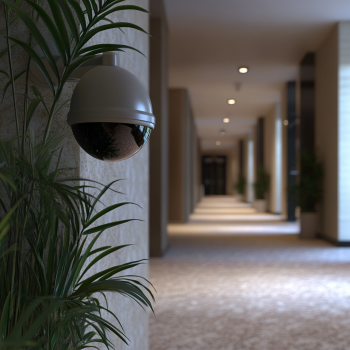Delve into the transformative power of AI cameras to enhance efficiency and elevate experiences across various sectors. In this article, we’ll explore the diverse insights provided by these intelligent technologies and how they can overcome their limitations to revolutionize business operations.
Table of contents:
- Understanding AI Cameras
- Key Types of Insights Provided by AI Cameras
- Integration with Other Technologies
- Case Studies: Neoma’s Successful AI Camera Implementations
- Overcoming the Limitations of AI Cameras
- Implementing AI Camera Solutions Effectively
- The Future of AI Cameras in Enhancing Operations
- From Insights to Action: Revolutionizing Business with AI Cameras
Understanding AI Cameras
In an era driven by artificial intelligence, AI-powered cameras have emerged as indispensable tools for businesses looking to boost operational efficiency and enrich customer experiences. These sophisticated devices transcend simple surveillance functions, offering a wealth of data-driven insights. By turning visual feeds into actionable intelligence, AI cameras are instrumental in guiding strategic decisions and sparking innovation across sectors.
AI cameras have evolved into more than just recording devices; they are state-of-the-art systems capable of real-time analysis and decision-making. Leveraging AI, machine learning, and computer vision, they process extensive visual data to provide insights that were previously unattainable. In a competitive market, maximizing these capabilities allows organizations to optimize operations and improve customer satisfaction, tailoring strategies based on detailed information about environments, behaviors, and patterns.
What are AI Cameras?
AI cameras are advanced imaging devices equipped with artificial intelligence capabilities, allowing them to analyze and interpret visual data without human intervention. Unlike traditional cameras that merely record footage for later review, AI cameras can process information in real time, recognizing patterns, detecting anomalies, and even predicting future events based on learned data.
The Transformation Over Time
The journey from basic surveillance cameras to intelligent AI systems has been propelled by advancements in technology. Early cameras served primarily as passive recording tools, requiring manual monitoring and analysis. The integration of AI and machine learning has shifted this paradigm, enabling cameras to actively analyze visual input, recognize objects, monitor movements, and generate insights instantly.
This transformation has opened new possibilities across various industries, from retail and hospitality to manufacturing and healthcare. By automating the analysis of visual data, AI cameras reduce the burden on human resources and increase the accuracy and speed of information processing.
Key Types of Insights Provided by AI Cameras
AI cameras offer a diverse range of insights that can be categorized into four main areas: customer experience, space monitoring, space safety, and access control.
| Insight Category | Description |
| Customer Experience | Gathers data on customer behavior and preferences to improve engagement and personalize services. |
| Space Monitoring | Analyzes occupancy levels and movement patterns for efficient space usage and resource allocation. |
| Space Safety | Detects potential safety risks, ensures compliance, and enhances security measures. |
| Access Control | Uses advanced authentication and visitor management systems to streamline access and maintain security. |
1. Customer Experience Insights
Customer Recognition and Analysis
AI cameras equipped with facial recognition technology can identify and recognize returning customers, allowing businesses to understand individual preferences and interactions within a space. By observing which areas customers frequent and the types of products or services they engage with, businesses can gain insights into customer interests and preferences.
Use Case: For example, when a loyal customer enters a bank, the system can recognize them and retrieve their profile, including their preferred banking services or products. This information enables the bank to optimize service delivery by directing the customer to their preferred teller or offering personalized financial advice based on their history. Additionally, targeted promotions for services that align with the customer’s interests—such as loan products or investment opportunities—can be presented, ultimately enhancing the overall banking experience and fostering stronger customer relationships
Enhancing Engagement
Facial recognition technology allows organizations to tailor services and offerings based on individual customer profiles. AI cameras can facilitate real-time adjustments to displays, staffing levels, or personalized greetings, creating a customized experience for each customer.
Use Case: In the hospitality industry, a hotel can use AI cameras to recognize VIP guests upon entry and promptly alert staff to provide special services or amenities. If facial recognition indicates that certain guests frequently gather in the lobby during specific times, the hotel can adjust staffing to accommodate guest needs or offer complimentary refreshments to enhance the experience.

2. Space Monitoring Insights
Occupancy Management
AI cameras provide real-time data on space utilization, helping businesses manage occupancy levels and comply with safety regulations. By monitoring the number of people in a given area, organizations can prevent overcrowding, especially in contexts where social distancing is essential.
Use Case: In corporate settings, facility managers can use these insights to optimize meeting room allocations, adjust heating and cooling systems based on occupancy, and reduce energy consumption.
Operational Efficiency
Understanding how spaces are used allows businesses to identify underutilized areas or bottlenecks that hinder efficiency. AI cameras can detect patterns in movement and usage, informing decisions about layout changes or resource reallocation.
Use Case: For instance, a manufacturing plant might use AI camera data to streamline workflow on the production floor, reducing congestion and improving productivity.
3. Space Safety Insights
Risk Detection
Safety is paramount in any environment. AI cameras enhance safety protocols by detecting potential hazards such as spills, obstructions, or unauthorized access to restricted areas. They can identify unusual activities or behaviors that may indicate security threats or emergencies.
Use Case: In public transportation hubs, AI cameras can monitor platforms and waiting areas for unattended luggage or suspicious behavior, enabling prompt responses to potential security risks.
Compliance and Security
AI cameras help ensure adherence to safety regulations and company policies. By monitoring compliance in real time, organizations can address issues promptly and maintain high safety standards.
Use Case: For example, in a construction site, AI cameras can verify that workers are wearing required protective gear and following safety procedures, reducing the likelihood of accidents and regulatory fines.
4. Access Control Insights
Advanced Authentication
Integrating facial recognition and other biometric technologies, AI cameras enhance access control systems. They provide secure and efficient authentication methods, reducing the risk of unauthorized entry.
Use Case: In residential complexes, AI cameras can streamline access for residents while maintaining high security levels. Visitors can be managed through temporary access codes or virtual check-ins, improving convenience without compromising safety.
Visitor Management
AI cameras facilitate efficient visitor management by automating the check-in process and maintaining detailed logs of entries and exits. This data helps organizations monitor visitor flow and enhance security protocols.
Use Case: In corporate offices, automated visitor management systems can expedite the check-in process for guests, provide badges, and notify hosts of arrivals, improving the overall visitor experience.
Integration with Other Technologies
AI cameras reach their full potential when integrated with other advanced technologies, particularly within the Internet of Things (IoT) ecosystem.
Synergy with IoT Devices
Connecting AI cameras with IoT devices creates smart environments, enabling comprehensive data collection and analysis. AI cameras interact with motion sensors and smart lighting to optimize building conditions in real time. If a room is unoccupied, IoT systems reduce lighting and HVAC use, boosting energy efficiency and cutting costs. This synergy crafts responsive spaces that enhance operational efficiency and user experience.
Artificial Intelligence of Things (AIoT)
The convergence of AI and IoT, known as AIoT, enhances both technologies by utilizing AI algorithms to analyze data from IoT devices. For AI cameras, this means smarter predictive analytics and autonomous responses. In manufacturing, AI cameras can identify equipment issues and, through AIoT, automatically adjust settings or request maintenance, reducing downtime and preventing failures. This integration optimizes operational efficiency and decision-making processes.

Case Studies: Neoma’s Successful AI Camera Implementations
1. Sports Industry
- Goal: A stadium operator aimed to enhance security and streamline the fan entry process by reducing wait times and improving access control.
- Action: By implementing Neoma’s Fan Identity Verification solution, which combines digital Fan IDs with real-time facial recognition through existing cameras, the operator transformed traditional access methods. This automated system allowed for quick identity verification and ticket validation, significantly reducing manual checks.
- Result: The automated verification process proved to be 50 times more efficient than manual methods, leading to a smoother flow of fans into the stadium. The solution not only improved security by detecting unauthorized individuals but also enhanced the overall fan experience.
Learn more about our solution here.
2. Hospitality Industry
- Goal: A luxury hotel aimed to enhance guest satisfaction and loyalty by providing personalized service and seamless recognition for both new and returning guests.
- Action: By integrating Neoma’s Guest Recognition solution, powered by the Gaia platform, the hotel equipped its staff with tools to instantly identify guests upon arrival. This system utilized tokenized facial recognition technology and integrated with existing systems (PMS, POS) to capture guest preferences and past interactions, enabling tailored experiences.
- Result: The implementation of this solution fostered genuine connections between staff and guests, significantly elevating guest satisfaction. The hotel reported improved operational efficiency and a more personalized service experience.
Learn more about our solution here.
3. Manufacturing Industry
- Goal: A leading cement factory in Asia aimed to improve security and operational efficiency at multiple entry points, addressing the challenge of managing access for numerous trucks and workers.
- Action: The facility used Neoma’s Gaia for real-time unauthorized detection and streamlined vehicle entry with facial authentication, edge computing, and UHF tags on trucks.
- Result: AI improved security and reduced wait times, saving the cement factory millions through better loss prevention and efficiency, showcasing Gaia’s transformative impact in manufacturing.
Read the full case study here.
Overcoming the Limitations of AI Cameras
While AI cameras offer significant benefits, they also present challenges that organizations must address to maximize their effectiveness.
1. Data Security Challenges
Protecting Sensitive Information
The collection and processing of visual data raise concerns about privacy and data security. Unauthorized access or breaches can lead to significant legal and reputational consequences.
Organizations must implement robust encryption methods, secure data storage solutions, and strict access controls to protect sensitive information captured by AI cameras.
Regulatory Compliance
Compliance with data protection regulations such as the General Data Protection Regulation (GDPR) is essential. Organizations must establish clear data handling policies, obtain necessary consents, and ensure transparency in data usage.
Regular audits and compliance checks can help maintain adherence to legal requirements and build trust with stakeholders.
2. Feed Quality and Camera Positioning
Optimizing Visual Data
High-quality data feeds are crucial for accurate analysis. Poor image resolution or frame rates can impair the AI’s ability to interpret visual information effectively.
Investing in advanced camera models with superior imaging capabilities ensures that the AI algorithms receive the best possible data for analysis.
Strategic Placement
The positioning and angles of cameras significantly impact the quality and coverage of visual data. Proper planning and testing are necessary to determine optimal locations that minimize blind spots and capture relevant activities.
Regular assessments and adjustments may be required to adapt to changes in the environment or operational needs.
3. Data Processing: Edge Computing vs. Cloud Computing
Edge Computing
Edge computing involves processing data locally on the device or nearby servers. This approach reduces latency, enabling faster responses and real-time decision-making. It also enhances privacy by keeping data within the local network.
Edge computing is beneficial in scenarios where immediate action is required, such as security alerts or time-sensitive operational adjustments.
Cloud Computing
Cloud computing leverages centralized servers to process and store data. It offers scalability and the ability to integrate data from multiple sources for comprehensive analysis.
Cloud solutions are suitable for long-term data storage, historical analysis, and situations where processing power requirements exceed local capabilities.
Choosing the Right Approach
Organizations must assess their specific needs to determine the most appropriate data processing method. Factors to consider include response time requirements, data sensitivity, bandwidth limitations, and scalability needs.
A hybrid approach combining edge and cloud computing can offer a balanced solution, providing real-time responsiveness while leveraging the analytical power of cloud platforms.

Implementing AI Camera Solutions Effectively
Successful deployment of AI cameras requires careful planning and consideration of various factors.
Integration with Existing Systems
AI cameras should be compatible with current infrastructure, including software platforms, hardware devices, and network configurations. Seamless integration ensures efficient data flow and maximizes the utility of insights generated.
Collaborating with technology providers and consultants can facilitate smooth implementation and customization to meet specific organizational needs.
Staff Training and Awareness
Employees must be trained to understand and utilize the insights provided by AI cameras. Promoting a culture that values data-driven decision-making enhances the effectiveness of the technology.
Training programs should cover not only technical aspects but also ethical considerations, data privacy, and compliance requirements.
Continuous Improvement
AI technology is continually evolving. Regular updates to AI models, software, and hardware components are necessary to maintain accuracy and efficiency.
Organizations should establish processes for ongoing evaluation, feedback collection, and system enhancements to adapt to changing needs and technological advancements.
The Future of AI Cameras in Enhancing Operations
Emerging Technologies
Advancements in AI, machine learning, and related technologies will further enhance the capabilities of AI cameras. Developments in 5G connectivity and the Internet of Things (IoT) will enable faster data transmission and more sophisticated real-time analysis.
Future AI cameras may incorporate advanced features such as emotion recognition, predictive analytics, and seamless integration with other smart devices.
Industry Applications
The potential applications of AI cameras extend across various sectors. In sports, they can analyze player movements and enhance fan experiences. Hospitality businesses can use them to personalize guest services and optimize staff deployment. Industrial sites benefit from monitoring safety protocols and detecting equipment malfunctions, while transportation sectors see improvements in traffic management and passenger experiences.
Organizations should stay informed about industry trends and explore innovative use cases to maintain a competitive edge.
Strategic Planning
Investing in AI camera technology should align with long-term organizational goals. Strategic planning involves assessing the potential return on investment, scalability, and adaptability of the technology.
AI camera insights can lead to a 25% increase in revenue through better decision-making. Engaging stakeholders across different departments ensures that the implementation supports broader objectives and delivers tangible benefits.
From Insights to Action: Revolutionizing Business with AI Cameras
AI cameras represent a significant advancement in technology, offering organizations the ability to gather detailed insights that drive efficiency, safety, and customer satisfaction. By understanding the types of insights available and addressing potential limitations, businesses can leverage AI cameras to transform operations and remain competitive in a rapidly evolving landscape.
The integration of AI cameras is not merely a technological upgrade but a strategic move toward data-driven decision-making and innovation. As AI and related technologies continue to advance, organizations that embrace these tools will be better positioned to meet the challenges and opportunities of the future.
Interested in learning more? Talk to Neoma Sales today.







